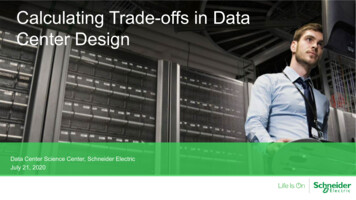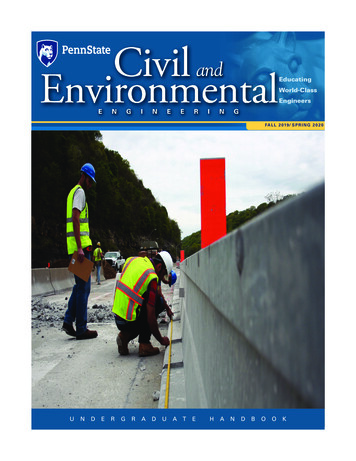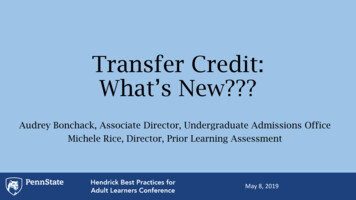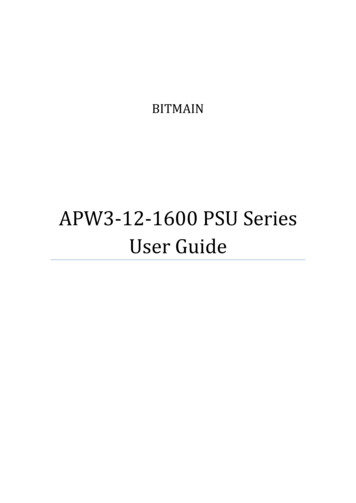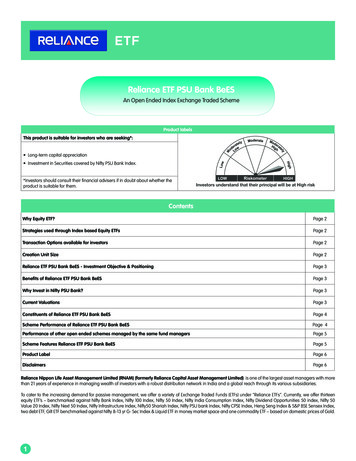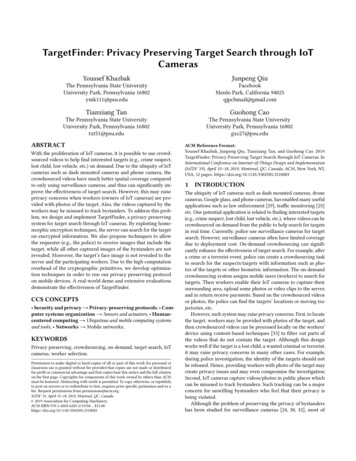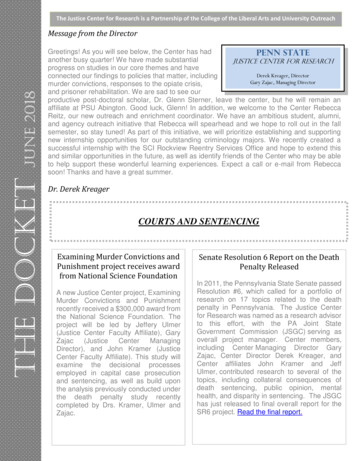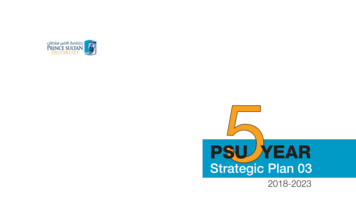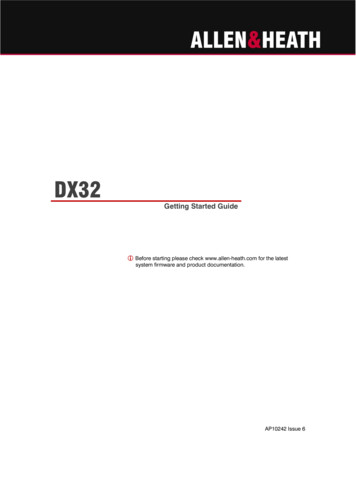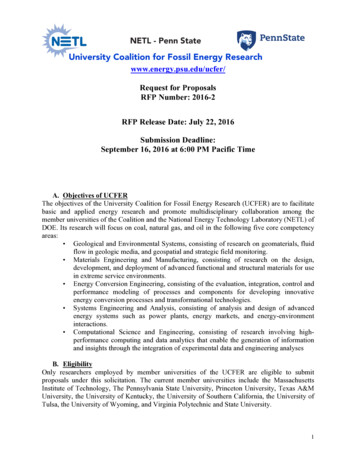
Transcription
www.energy.psu.edu/ucfer/Request for ProposalsRFP Number: 2016-2RFP Release Date: July 22, 2016Submission Deadline:September 16, 2016 at 6:00 PM Pacific TimeA. Objectives of UCFERThe objectives of the University Coalition for Fossil Energy Research (UCFER) are to facilitatebasic and applied energy research and promote multidisciplinary collaboration among themember universities of the Coalition and the National Energy Technology Laboratory (NETL) ofDOE. Its research will focus on coal, natural gas, and oil in the following five core competencyareas: Geological and Environmental Systems, consisting of research on geomaterials, fluidflow in geologic media, and geospatial and strategic field monitoring. Materials Engineering and Manufacturing, consisting of research on the design,development, and deployment of advanced functional and structural materials for usein extreme service environments. Energy Conversion Engineering, consisting of the evaluation, integration, control andperformance modeling of processes and components for developing innovativeenergy conversion processes and transformational technologies. Systems Engineering and Analysis, consisting of analysis and design of advancedenergy systems such as power plants, energy markets, and energy-environmentinteractions. Computational Science and Engineering, consisting of research involving highperformance computing and data analytics that enable the generation of informationand insights through the integration of experimental data and engineering analysesB. EligibilityOnly researchers employed by member universities of the UCFER are eligible to submitproposals under this solicitation. The current member universities include the MassachusettsInstitute of Technology, The Pennsylvania State University, Princeton University, Texas A&MUniversity, the University of Kentucky, the University of Southern California, the University ofTulsa, the University of Wyoming, and Virginia Polytechnic and State University.1
C. Collaboration RequirementsUCFER represents an innovative and novel approach to engage academic institutions for thepurpose of collaboration with NETL R&D. Therefore, collaboration with NETL is mandatory forall UCFER research projects. NETL’s research capabilities and expertise are specificallyaddressed in the attached Research Topic Areas (see Attachment A). Applicants are alsoencouraged to consider potential collaboration with industry. There should be no costs budgetedfor collaboration efforts with NETL. Any proposal failing to provide written statement ofproposed collaboration with NETL will be considered non-responsive and not forwardedfor review.D. Research Topic AreasProposals are being solicited from the UCFER members in the following research areas: Carbon CaptureOil & Gas – Natural Gas InfrastructureAdvanced CombustionSee Attachment A for a description of the research topic areas, objectives, and requirementscovered under this solicitation. A description of the core competency areas is provided inAttachment B. Attachment C shows the relationship between core competency area and researchtopic areas.E. Funds Available for This SolicitationThe total amount available for awards under this solicitation is anticipated to be approximately 2,080,000. Estimated funding levels per research area are as follows: Carbon Capture ( 814,000)Oil & Gas – Natural Gas Infrastructure ( 407,000)Advanced Combustion ( 859,000)F. Cost-Share RequirementsCost-share requirements are based on Technology Readiness Levels (TRLs). TRL definitions aregiven in Attachment D. Researchers are encouraged to use these TRL definitions in order toevaluate the status of their given technology. “TRL start” is the applicant’s evaluation of thetechnology at onset of the proposed project. “TRL end” would mean the projected end state TRLfor their technology. Singular TRL values (no ranges) at both start and end state should besupplied.There is no minimum cost share requirement for research activities at the basic/fundamentalstage. Research at this stage can be classified in the following range of TRLs: 1-2. There is aminimum requirement of 20% cost share for research activities at the applied stage. Research atthis stage can be classified in the following range of TRLs: 3-6. Cost share requirements for aproposed project are based on the TRL value at the start state.When cost share is required, the proposal’s cost share must be calculated as a percentage of theTotal Project Costs and not a percentage of the funds requested from the UCFER. Cost share,which may be in the form of cash or in-kind contributions, is acceptable as part of the matchprovided it meets the following criteria:2
Is verifiable, necessary, and reasonable for proper and efficient accomplishment ofthe project.Is incurred within the project performance period. Previously expended research,development, or exploration costs are unallowable.Is not included as cost share for any other federal project, is not paid with funds fromthe federal government, and is otherwise allowable in accordance with applicablefederal cost principles and DOE regulations governing cost sharing.The value of patents and data contributed to the project is unallowable as costsharing.Proposed projects are not required to show TRL advancement unless specified within a givenresearch topic area. Significant research findings and results may come from projects that startand end at the same TRL.G. Subcontract AwardsSubcontracts will be issued from The Pennsylvania State University to the successful applicants.The duration of the subcontract will vary based on the description of the research topic areaguidelines covered under this solicitation in Attachment A. Anticipated start dates of thesubcontracts are 45-60 days after selection. The start date will depend on the timing of NETLapprovals regarding project budget, Environmental Questionnaire, and Foreign Nationals.If additional documentation/justification is required prior to issuance of a subcontract, a delay insubmission could result in a delay in issuance of the subcontract.H. SubmissionThe final deadline for receipt of proposals is 6 PM Pacific Time on September 16, 2016.Proposals received after the deadline will not be accepted. Proposals must be submittedelectronically to the web portal: www.energy.psu.edu/ucfer to be considered for review andevaluation. Log-in information has been provided to each university TAC representative. Log-ininformation can also be obtained by emailing ucfer-omt@ems.psu.edu. Applicants areresponsible for verifying successful transmission, prior to the application due date and time.Early submissions are encouraged.I. Proposal FormatAll proposals must follow the following format. Each page of the proposal should be numberedat the bottom. The font type must be clear and legible, the font must be 12 point, line spacingmust be 1. , margins must be 1 inch (top, bottom, and sides), and the paper size must be 8.5 x 11inches.Sections of the ProposalThe proposal must contain the following sections in order. See Attachments E through G forproposal elements.ChecklistSee Attachment EThis is used to ensure that all elements of the proposal have been completed.Cover SheetSee Attachment FNote that the proposal must be signed by an authorized/official university representative.3
Table of ContentsOne (1) page maximumExecutive Summary (Public Abstract)One (1) page maximumProvide a one-page summary of the proposed research containing the title of the project andindicating the relevance to the specific research area in the solicitation. It should clearly state theproblem, the objectives of the proposed research, idea or concept, the approach, anticipatedbenefits and impacts, and partner organization(s). This self-contained document should besuitable for use as public abstract. It should be informative to other persons working in the sameor related fields and, insofar as possible, understandable to the lay reader. This document mustnot include any proprietary or sensitive business information as the Coalition and/or DOE maymake it available to the public.Project DescriptionFive (5) page maximumThe main body of the proposal should outline the problem, the proposed approach, theobjectives, and plan of work, including the broad design of activities to be undertaken. At aminimum the following should be discussed: Statement of the problemObjectives and proposed approachStatement of the work planRelation of the proposed work to comparable work reported or in progress, includingaccomplishments of antecedent UCFER projects, if applicable.Description of available facilities and major items of equipment available for theworkReference citations: references should be relevant, numbered, cited in the text andlisted at the end of the text. The list of numbered references does not count against thepage limit.Project ScheduleOne (1) page maximumInclude a plan establishing a schedule for accomplishing the work. The plan should includemajor milestones of the project in bar chart format and should cover the complete period ofperformance.Anticipated Results and ImpactsOne (1) page maximumDiscuss the anticipated benefits and impacts of the research and, if applicable, the viability of theproposed research for commercialization. Describe how the project will advance the basic orapplied fossil energy research. Identify any specific groups in the commercial sector that mayuse the projected results.Description of the Collaborative Work with NETL Two (2) pages maximumDescribe the nature of the proposed collaborative R&D work with NETL, how and where thatwork will be conducted, what (if any) NETL facilities, software and equipment will be used, howcommunications with NETL will be conducted, and the prospects of sustained collaboration inthe future. The applicants may propose staff exchanges and sabbatical programs underappropriate arrangements. The applicants may also propose activities involving jointly advisedstudents, and other research collaborations. Any relevant prior collaboration with NETL shallalso be discussed.4
Under each research topic or subtopic, information is provided about collaboration opportunitiesfor UCFER researchers such as the kind of activities and support NETL can provide, FTE levelsof NETL scientists and engineers, and NETL facilities and usage time that will be madeavailable to university coalition researchers. Describe the nature of the proposed collaborativeR&D work with NETL based on this information. The costs for NETL employees (FTEs, etc.)and testing resources are not to be included in proposal budgets.There is no need nor is it encouraged to identify an NETL point of contact in your proposal. Nodiscussion with NETL employees regarding this proposal development effort is needed. If yourproposal is selected under the RFP, an NETL employee will be assigned at that time for you tocontact.Budget (Refer to Attachment G, Template)A reasonable budget is an important part of a good proposal. Your budget may request fundsunder any of the categories listed on Attachment G, as long as the item and amount areconsidered necessary to perform the work. It is expected that the participants will already havemost of the necessary permanent equipment to conduct the research. The majority of the fundingis to support research activities. Proposed equipment expenditures are permitted; but theirpurchase must be justified. Refer to 2 CFR 200.313 for federal regulations regarding equipment.Permanent equipment purchases are discouraged, but will be considered during the proposalevaluation.Cost-Share CommitmentsAll cost-share commitments must meet the requirements set forth above and be supported byappropriate documentation. Third parties proposing to provide all or part of the required costshare must include a letter stating their commitment to provide a specific minimum dollaramount of cost-share. The letter should also identify the proposed cost share (e.g., cash, services)to be contributed. Letters must be signed by the person authorized to commit the expenditure offunds and be provided in PDF format. Failure to provide appropriate documentation can result inthe proposal being returned without review.Biographical SketchesTwo (2) pages per person maximumVitae of key personnel involved in the project must be provided and should include educationalbackground, professional experience, research interest, honors, professional activities and 10relevant publications.Collaborative DocumentationAll collaborations with university partners within the UCFER, not included in the budget, shouldbe described with a letter from each collaborator. At a minimum, the letter should describe thecollaboration to be provided, resources to be provided, schedule, and budget information.OtherLetters of support from outside sources are encouraged, but not mandatory.J. Treatment of Proprietary InformationPrivileged, confidential, or financial information that the applicant does not want disclosed to thepublic or used by the federal government for any purpose other than application evaluation,should be specifically identified by page and lines on the proposal cover sheet.5
K. Proposal Evaluation/Review ProcessAll proposals will undergo a preliminary review to ensure that all proposal elements areaddressed, and that any potential conflict of interest issues are identified. Collaboration withNETL is mandatory. Any proposal failing to provide NETL collaboration will beconsidered non-responsive and not forwarded for review.All proposals determined to be responsive to the solicitation will be forwarded for review inaccordance with the evaluation criteria set forth in the solicitation and the amount of fundingavailable for the solicitation. The UCFER Director will notify all applicants around December 1,2016, by letter, of the final decision regarding their proposals.L. Evaluation Criteria (Refer to Attachment H)The proposals will be evaluated per the following 100-point criteria: Merit of proposed collaboration with NETL—maximum of 20 pointsMeeting UCFER objectives—maximum of 10 pointsIdea and approach—maximum of 20 pointsProject achievability—maximum of 10 pointsResearch impacts—maximum of 15 pointsQualification of key personnel—maximum of 15 pointsProject management—maximum of 5 pointsProject budget—maximum of 5 pointsThe proposal evaluation forms are provided in attachment H for reference. Evaluations will beperformed on-line at a secure, members-only, website portal.M. Environmental QuestionnaireAll applicants must prepare Environmental Questionnaire on the NETL form F 451.1-1/3. TheEnvironmental Questionnaire can be found online for downloading at the UCFER website:www.energy.psu.edu/ucfer. The Environmental Questionnaire must be attached at the end of theproposal.N. Foreign National DocumentationA foreign national is defined as any person who was born outside the jurisdiction of the UnitedStates, is a citizen of a foreign country, and has not been naturalized under U.S. law. If applicantspropose work with foreign nationals as project team members, they will be required to providethe foreign national information upon selection for award. All successful applicants includingforeign nationals as team members, will be required to complete the Foreign NationalDocumentation before they can attend DOE meetings or visit DOE sites. Recipients ofsubawards under the UCFER will be required to complete Foreign National Documentation, ifapplicable, to facilitate UCFER responsibilities associated with foreign national access to DOEsites, information, technologies, equipment, programs or personnel. Any UCFER member failingto comply with the Foreign National requirement will not be eligible to receive DOE funding.Information that will be required include: u.edu/ucfer)Colored copy of passportPicture visa – from the passport book even if it is expired (color copy)foundat6
LPR card – foreign national may have this instead of a visa (photocopy in color, bothfront and back)EAD card – foreign national may or may not have this (photocopy in color, both frontand back of the cardOther documents that allow foreign national to be in the states, such as I-20, DS2019, etc.Resume (will need this if they are doing an assignment of more than 30 days)O. Additional InformationFrequently asked questions (FAQs) from the first solicitation cycle can be found in the ‘MemberLogin’ at: www.energy.psu.edu/ucfer/?q memberonly/FAQs.html. Additional questions shouldbe forwarded to the UCFER Director at ucfer-director@ems.psu.edu.7
ATTACHMENT A – RESEARCH TOPIC AREASUniversity Coalition for Fossil Energy Research (UCFER)Research Topic Guidance DocumentSolicitation 2 - Summer 2016RFP Number: 2016-28
Univeristy Coalition for Fossil Energy Research (UCFER)Research Topics Summary - Summer 2016Table 1 Available UCFER funds by Technology Line.AvailableResearch FundsTechnology Line( K)Carbon Capture 814Oil and Gas 407Advanced Combustion 859TOTAL (Round 2 Solicitation) 2,080Table 2 Overview of UCFER Topics/Subtopics and award information for Round 2 Solicitation.AnticipatedProjectUCFER Research TopicsPeriodMaximumExpected NumberCost Shareby Technology Line(Months)Award Sizeof AwardsRequirement[E-1] Carbon Capture - Transformational Membrane Materials for Carbon CaptureSubtopic E-1a: Innovative PolymericMembrane Materials for Separation of18approx. 300,0000 to 2CO2/N2Subtopic E-1b: Thin Film Fabrication andCharacterization for Polymeric Gas18approx. 232,0000 to 2Separation MembranesSubtopic E-1c: Hollow Fiber Membrane18approx. 300,0000 to 2Module DesignSubtopic E-1d: Phase Change Solvent18approx. 100,0000 to 2Materials for Separation of CO2/N2[E-2] Carbon Capture - Support for 2nd Generation Carbon Capture Technology Scale-UpSubtopic E-2a: Validated Volume of Fluid(VOF) Simulations to Develop Models forInterfacial Area and Mass Transfer12approx. 200,0000 to 1TRL 1-2: n/a;TRL 3-6: 20% minimumTRL 1-2: n/a;TRL 3-6: 20% minimum20% minimum20% minimum20% minimum[F-1] Oil & Gas (NG Infrastructure) - Measuring and Monitoring the Air Quality Impacts of Unconventional Oiland Gas (UOG) DevelopmentSubtopic F-1a: Fugitive Air Emmission12-24approx. 400,0000 to 120% minimumfrom Point Sources[G-1] Advanced Combustion - Supercritical CO2 Power CyclesSubtopic G-1a: CFD Model Development 200,000 TRL 1-2: n/a;for Direct Fired Supercritical CO2 Power12-240-2 400,000TRL 3-6: 20% minimumCycle's[G-2] Advanced Combustion - Chemical Looping CombustionSubtopic G-2a: Oxygen Carriers for 200,000 TRL 1-2: n/a;Chemical Looping Combustion of Solid12-240 to 2 400,000TRL 3-6: 20% minimumFuels[G-3] Advanced Combustion - Novel ConceptsSubtopic G-3a: Novel Concepts for 200,000 TRL 1-2: n/a;12-240 to 2Advanced Combustion 400,000TRL 3-6: 20% minimum9
Table 3 Applicable NETL Core Competencies for each Round 2 Solicitation research subtopic.MaterialsEnergyGeological &Engineering &ConversionUCFER Research TopicsEnvironmentalManufacturingEngineeringby Technology LineSystems (GES)(MEM)(ECE)[E-1] Carbon Capture - Transformational Membrane Materials for Carbon CaptureSubtopic E-1a: Innovative PolymericMembrane Materials for Separation ofXCO2/N2Subtopic E-1b: Thin Film Fabrication andCharacterization for Polymeric GasXSeparation MembranesSubtopic E-1c: Hollow Fiber MembraneXModule DesignSubtopic E-1d: Phase Change SolventXMaterials for Separation of CO2/N2[E-2] Carbon Capture - Support for 2nd Generation Carbon Capture Technology Scale-UpSubtopic E-2a: Validated Volume of Fluid(VOF) Simulations to Develop Models forInterfacial Area and Mass TransferSystemsEngineering &Analysis (SEA)ComputationalScience &Engineering(CSE)XXXX[F-1] Oil & Gas (NG Infrastructure) - Measuring and Monitoring the Air Quality Impacts of Unconventional Oil and Gas (UOG)DevelopmentSubtopic F-1a: Fugitive Air EmmissionXfrom Point Sources[G-1] Advanced Combustion - Supercritical CO2 Power CyclesSubtopic G-1a: CFD Model Developmentfor Direct Fired Supercritical CO2 PowerXCycle's[G-2] Advanced Combustion - Chemical Looping CombustionSubtopic G-2a: Oxygen Carriers forChemical Looping Combustion of SolidXFuels[G-3] Advanced Combustion - Novel ConceptsSubtopic G-3a: Novel Concepts forAdvanced CombustionSelf-Identification Self-Identification Self-Identification Self-Identification Self-Identificationby Applicantby Applicantby Applicantby Applicantby Applicant10
E: CARBON CAPTUREThe Carbon Capture Program at the National Energy Technology Laboratory (NETL) isdeveloping technologies that will enable cost-effective implementation of carbon capture andstorage (CCS) in the power generation sector and ensure that the United States will continue tohave access to safe, reliable, and affordable energy from fossil fuels. The program consists oftwo core research technology areas, post-combustion capture and pre-combustion capture, andalso supports related carbon dioxide (CO2) compression efforts. Current research anddevelopment (R&D) efforts are advancing technologies that could provide step-changereductions in both cost and energy penalty compared to currently available technologies. Thegoals of the Carbon Capture program are: By 2020, complete R&D of 2nd generation carbon capture technologies that can reducethe cost of electricity (COE) over current state-of-the-art technologies by 20%. By 2025, complete R&D of transformational carbon capture technologies that can reducethe COE over current state-of-the-art technologies by 30%.Area of Interest (E-1)Transformational membrane Materials for Carbon CaptureOverviewNETL, through its Carbon Capture Program, is investigating transformational, low-costtechnology solutions that allow leveraging and competitive operation of our nation's fossil-basedpower generation infrastructure in a low-carbon future. The objective of the research is toidentify transformational capture concepts that can enable the Carbon Capture Program goalsthrough the development of advanced materials and processes that are able to reduce the energypenalty and cost of CO2 separation over conventional technologies.It is commonly understood that conventional polymeric gas separation membranes exhibit atrade-off between flux and gas pair selectivity. In Robeson plots of selectivity versuspermeability, it is shown that most common polymers cannot achieve both higher selectivity andpermeability than a phenomenologically determined upper bound curve. However, in carboncapture applications employing membranes for CO2/nitrogen gas (N2) or CO2/hydrogen gas (H2)separation, having high selectivity and permeability are linked to a reduced cost of capture.Therefore, materials that approach or exceed the Robeson upper bound are of great interest.Furthermore, when membranes are incorporated into large-scale modules, it is common for thegas separation performance of the membranes to be reduced due to mass transport limitationsrelated to the membrane packing geometry and gas flow arrangement. Therefore, effectivemembrane module design can also have a large impact on carbon capture cost.11
Technology Specific Goals and Priorities1) The overall goals of this research is to advance CO2 capture and separation systemsbeyond 2nd Generation economic performance predictions, through the development andtesting of transformational CO2 capture systems for new and existing coal-based powerplants.Challenges1) Transformational technologies, are required to meet the overall fossil energy performancegoals of 90% CO2 capture rate with 95% CO2 purity at a COE 30% less than baselinecapture approaches (Baseline cost and performance: DOE/NETL-2010/1397, Sept 2013.).Subtopic Area E-1aInnovative Polymeric Membrane Materials for Separation of CO2/N2The goal of this subtopic is to develop novel polymeric membrane materials for the separation ofCO2 from N2 in post-combustion flue gas. These materials should show the potential forachieving a CO2 permeability greater than 300 Barrer and a CO2/N2 selectivity greater than 40.They should also be stable when exposed to water and common contaminants such as SOx andNOx. Materials must be mechanically stable and capable of being formed into thin films on flatsheet and hollow fiber supports. Proposals may include thermally rearranged polymers, blockcopolymers, polyether polymers, fluorinated polymers, facilitated transport polymers, or otherinnovative, tunable formulations. Also unique approaches for reducing the physical aging orplasticization effects of polymers are encouraged. Projects may start at any TRL stage. However,it is expected that projects will achieve TRL 3 or greater by the end of the project period. Thereis no cost share requirement for projects starting at TRL 1 or TRL 2. Projects starting at TRL 3or greater are required to provide a minimum of 20% cost share.Collaboration Opportunities with NETLMaterials Engineering & Manufacturing (MEM) Core Competency: Applicants have theopportunity to collaborate with the NETL research staff on the fabrication and evaluation ofcarbon capture materials. The polymeric materials under development may be tested in NETL’sMembrane Preparation Laboratory for their compatibility with filler particles including metalorganic frameworks or porous organic polymers, in order to form mixed matrix membranes andto fabricate thin film composite hollow fiber membranes using NETL facilities which include ahollow fiber spinning apparatus and a spray coating device. Up to 0.1 FTE of NETL labor willbe available for fabricating films, conducting characterization tests, and interpreting data. Gaspermeance for both hollow fiber and flat sheet membranes may be tested using simulated oractual flue gas. Simulated flue gas experiments will be conducted at the Reaction Chemistry andEngineering Laboratory at NETL’s Pittsburgh Site. The tests are optimized for 25 mm flat sheet12
coupons or single strand hollow fiber modules. The operating pressure is 1-50 bar, operatingtemperature is 40-250 oC, gas flow rate is up to 50 SCCM, and the gas composition is typical forflue or fuel gas, including moisture and contaminants. The experimental set up is described indetail in Venna et al. (2015) [6]. The laboratory will be available for up to 20 working daysduring the first year. Up to 0.1 FTE of NETL labor will be available for designing theexperiments, conducting the laboratory tests, and interpreting data. Projects awarded through thissolicitation that achieve satisfactory performance in simulated environments during the first yearmay have the opportunity to collaborate with NETL to test under actual flue gas environments atthe National Carbon Capture Center (NCCC) [5]. The NCCC facility may be available for up to3 working days during the second year. Up to 0.1 FTE of NETL labor may be available fordesigning the NCCC experiments, conducting the laboratory tests, and interpreting data. Testingat NCCC is contingent upon resource availability.Award Information and Funding Amounts:Area of InterestE-1aAnticipated Project PeriodMaximum Award SizeExpected Number ofAwardsCost Share Requirement18 monthsapprox. 300,0000 to 2 AwardsTRL 1-2:n/aTRL 3-6:20% minimumReferences[1] EIA Annual Energy Outlook 2012 with Projections to 2040, Report #:DOE/EIA-0383(2013),April 2013.[2] National Energy Technology Laboratory, Carbon Capture Technology Program Plan, r/pubs/Program-Plan-Carbon-Capture-2013.pdf[3] National Energy Technology Laboratory, CO2 Emissions Control /ewr/co2/index.html[4] For additional information on CCSI, please visit https://www.acceleratecarboncapture.org/[5] U.S. Department of Energy, National Carbon Capture Center Website:http://nationalcarboncapturecenter.com/13
[6] S. R. Venna, M. Lartey, T. Li, A. Spore, S. Kumar, H. Nulwala, D. R. Luebke, N. L. Rosi andE. Albenze, Fabrication of MMMs with improved gas separation properties using externallyfunctionalized MOF particles, J. Mater. Chem. A, 3 (2015) 5014.Subtopic Area E-1bThin Film Fabrication and Characterization for Polymeric Gas Separation MembranesThe goal of this subtopic is to develop novel fabrication and characterization techniques for freestanding and composite thin film polymeric membranes. Of particular interest are thin filmcomposite membranes that can be successfully applied to a hollow fiber support while achievinga defect-free selective layer thickness of 1 micron. The methods used should be able to beincorporated in a continuous hollow fiber spinning process at industrial production scales. Novelcharacterization techniques for probing the solubility, diffusivity, morphology, densification, freevolume, and other relevant properties of the thin films are encouraged. Projects may start at anyTRL stage. However, it is expected that projects will achieve TRL 3 or greater by the end of theproject period. There is no cost share requirement for projects starting at TRL 1 or TRL 2.Projects starting at TRL 3 or greater are required to provide a minimum of 20% cost share.Collaboration Opportunities with NETLMaterials Engineering & Manufacturing (MEM) Core Competency: Applicants have theopportunity to collaborate with NETL researchers to fabricate thin film composite hollow fibermembranes using NETL facilities, which include a hollow fiber spinning apparatus and a spraycoating device. These facilities will be available for up to 20 working days and up to 0.1 FTE ofNETL labor will be available for fabricating films, conducting characterization tests, andinterpreting data. Gas permeance for hollow fiber membranes may be tested using simulated oractual flue gas. Simulated flue gas experiments will be conducted at the Reaction Chemistry andEngineering Laboratory at NETL’s Pittsburgh Site. The test are optimized for 25 mm flat sheetcoupons or single strand hollow fiber m
RFP Number: 2016-2 RFP Release Date: July 22, 2016 Submission Deadline: September 16, 2016 at 6:00 PM Pacific Time A. Objectives of UCFER The objectives of the University Coalition for Fossil Energy Research (UCFER) are to facilitate basic and applied energy research and promote multidisciplinary collaboration among the
